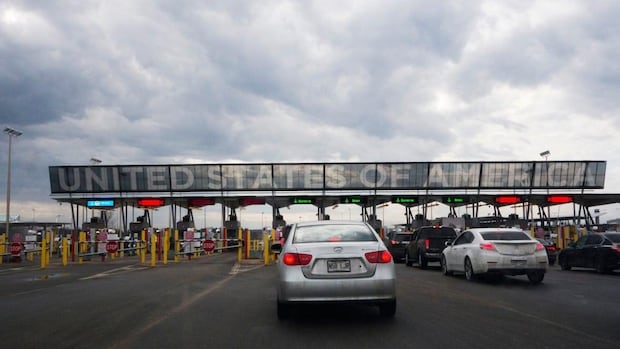Asylum claims doubled at a Quebec border crossing in April as the Trump administration seeks to strip legal protections from hundreds of thousands of migrants in the United States.
There were 2,733 asylum claims last month at the Saint-Bernard-de-Lacolle port of entry, south of Montreal. That’s up from 1,356 claims in March and 755 in February, according to data from the Canada Border Services Agency.
The April total represents a fourfold increase over the same month last year, when there were 670 asylum claims at the Quebec border crossing. The numbers run counter to the trend in refugee claims across Canada, which have declined dramatically since last year.
“To address this situation, additional resources have been put in place to ensure safe and secure border management,” said Guillaume Bérubé, a spokesperson for the border agency, in an email. He mentioned the agency has been working to lease a new space at the border crossing to use as a processing centre.
The steady increase in asylum claims at the Quebec border crossing coincides with U.S. President Donald Trump’s efforts to revoke temporary protected status for 600,000 Venezuelans and 500,000 Haitians living in the U.S., first made public in February.
That status allows people already in the U.S. to live and work legally because their native countries are deemed unsafe for return due to natural disaster or civil strife. Its withdrawal could lead to them being deported.
Abdulla Daoud, executive director of the Montreal-based Refugee Centre, said many asylum seekers entering at Saint-Bernard-de-Lacolle are from Haiti, Venezuela and Colombia.
Still, he pointed out that the increase to date is a far cry from the “massive influx of immigrants” that Quebec Premier François Legault warned about after Trump’s November re-election. At the time, Parti Québécois Leader Paul St-Pierre Plamondon said millions of people might consider moving north to Canada.
“There is a fearmongering narrative around the numbers coming into Canada,” Daoud said. “Trump is threatening Canada in a lot of different ways, and this is not one of them.”
Situation today differs from years prior
Despite the increase at the Saint-Bernard-de-Lacolle crossing, the overall number of asylum claims in Canada has dropped this year. The border agency says it has processed about 12,500 asylum claims in Canada so far in 2025, compared to roughly 25,500 by this time last year – a decline of nearly 50 per cent. In Quebec, there have been 8,165 claims this year, compared to just over 14,000 by the same date in 2024.
The agency says those numbers include would-be refugees who are found ineligible to claim asylum in Canada, which is the case for many of those who try to enter the country from the U.S.
Under the Canada-U.S. Safe Third Country Agreement, people must claim asylum in whichever country they get to first, meaning they can’t leave the U.S. to seek refugee status in Canada. Some people qualify for exceptions to the agreement — most notably those who have a family member in Canada — and must prove their eligibility during an interview with border agents.
The border agency says it has returned 1,439 asylum seekers to the U.S. so far this year because they were ineligible under the Safe Third Country Agreement.
There has been a significant change in the number of asylum claims since U.S. President Donald Trump took office, specifically at the regular border crossing in Lacolle, Que., according to Canada Border Services Agency (CBSA) data obtained by Radio-Canada and CBC News. The data shows there had already been 557 asylum claims at Lacolle in the first six days of April — just three fewer than in all of January.
Daoud said the situation today is very different from a few years ago, when a steady stream of asylum seekers entered Canada at an unofficial border crossing along Roxham Road in Quebec, using a loophole in the Safe Third Country Agreement. At that time, he said, many of the would-be refugees had only recently arrived in the U.S., and were using it as a transit point to get to Canada.
But that loophole was closed in 2023, effectively shutting down Roxham Road and making a flood of asylum seekers much less likely, according to Daoud. He said people at risk of losing temporary protected status in the U.S. have other options, including seeking asylum in that country, and won’t necessarily look to Canada as their only recourse. Many of them have been living in the U.S. for years, he said.
“A lot of groups are fighting for those individuals to have the right to stay there because that is their home. So it’s not the same profile of individuals,” he said. “So you’re not going to see that dramatic increase.”
Many of the people showing up at the Quebec border crossing are choosing to come to Canada because they have family here, he said.
The Trump administration’s move to withdraw temporary protected status has already faced pushback. In March, a federal judge in San Francisco ordered a pause on plans to strip legal protections from 350,000 Venezuelans in April. He found that the expiry of their protected status threatened to severely disrupt the lives of hundreds of thousands of people and could cost billions of dollars in lost economic activity.
Last week, the Justice Department asked the U.S. Supreme Court to lift that court order.
The Canadian border agency also says it has increased removals of people who are inadmissible to Canada. It says it removed more than 16,000 people in the 2023-24 fiscal year, up from 7,500 in 2021-22.

